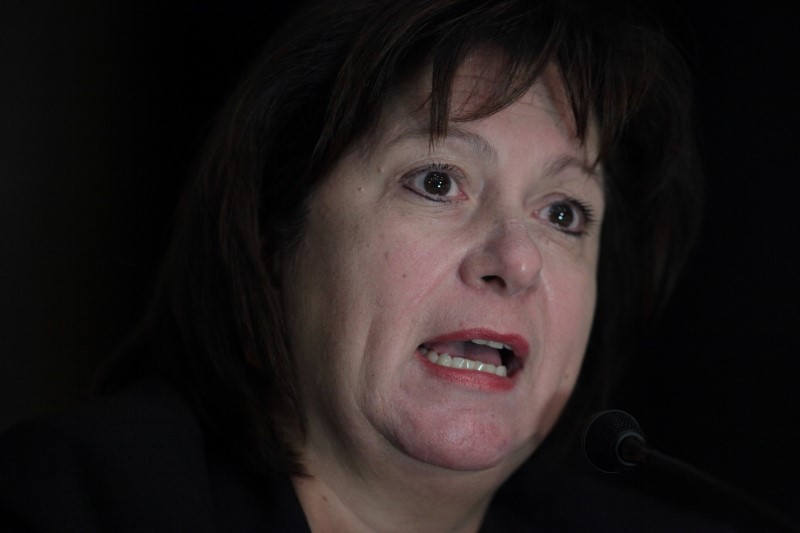 © Reuters. Natalie Jaresko, Executive Director of the Federal Fiscal Control Board of Puerto Rico attends a meeting of the Financial Oversight and Management Board for Puerto Rico at the College of Engineers and Land Surveyors in San Juan
© Reuters. Natalie Jaresko, Executive Director of the Federal Fiscal Control Board of Puerto Rico attends a meeting of the Financial Oversight and Management Board for Puerto Rico at the College of Engineers and Land Surveyors in San JuanBy Daniel Bases
NEW YORK (Reuters) – Structural reforms could boost Puerto Rico’s economy by as much as 1.5 percent, but federal tax law changes on top of deadly hurricanes pose additional challenges, the executive director of the island’s financial oversight board said.
Natalie Jaresko, who leads the federally appointed Financial Oversight and Management Board’s executive team, said she expects the revised fiscal reform plans submitted by the U.S. commonwealth’s government to be certified on March 26.
The three critical structural reform areas she highlighted were the electrical grid, overseen by the beleaguered Puerto Rico Electric Power Authority (PREPA) that is slated to be partially privatized; labor market reforms; and making it easier to do business.
“What is really critical is that they do these structural reforms that can deliver billions of dollars (to the budget) in the out years, if done now and in a way that is meaningful, not incremental or slow,” she said in a telephone interview from San Juan late on Wednesday.
“Getting those things done could add 1 to 1.5 percent of GNP (gross national product) growth and that could create the real stable turnaround in the economy that is necessary to do a fixed piece of debt,” she said.
Under a 2016 federal Puerto Rico rescue law known as PROMESA, Congress appointed six members to a board tasked with managing the territory’s finances, with President Barack Obama adding a seventh. PROMESA gave the board authority to push Puerto Rico into a court-supervised debt restructuring akin to U.S. bankruptcy.
The island is navigating the largest government bankruptcy in U.S. history, with $120 billion of combined bond and pension debt when it declared bankruptcy in May 2017 after more than a decade of recession.
REBUILD
September’s Hurricane Maria was Puerto Rico’s worst natural disaster in 90 years, killing dozens, decimating local infrastructure and knocking out power to the island’s 3.4 million U.S. citizens.
More than five months later more than 8 percent, or 120,991 customers remain without power, according to the U.S. Department of Energy.
Jaresko said it was safe to say approximately $35 billion to $45 billion has been appropriated for relief and rebuilding, including earmarks from the U.S. Congress and money from the Federal Emergency Management Agency (FEMA), which is not fixed.
That overall range does not include $4.8 billion in Medicaid money, nor roughly $4.8 billion in unreleased Community Development Loans. She noted another estimate of $21 billion in private insurance that will provide an economic stimulus.
One of the board’s main focus points is to restructure the electrical grid, lower the cost of electricity and make the power supply more reliable, Jaresko said.
If electric rates are low and stable, they would create a revenue stream that would allow the government to restructure the more than $9 billion of defaulted PREPA debt, she said.
PREPA had a deal with creditors but it was never certified by the board.
“Frankly speaking, one of the reasons that deal was not approved by the board… is if we don’t bring down the cost of electricity, we will continue to have people moving off the grid,” and the ability to repay debt becomes even more of a challenge, she said.
For decades, favorable U.S. tax treatment allowed the economy to be built with a competitive advantage. While those advantages eroded over time and led to the recession, December’s U.S. tax law changes stripped away the last benefits.
“To remove it without the ability to plan and build other competitive advantages is extraordinarily difficult. To have to do that without notice and then have to do that while rebuilding the economy… I think it is very difficult policy timing.”
Source: Investing.com




























